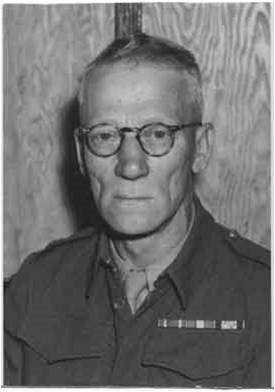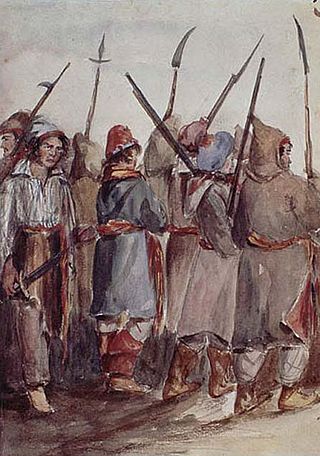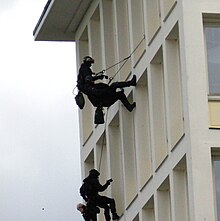
Infantry is a specialization of military personnel who engage in warfare combat. Infantry generally consists of light infantry, irregular infantry, heavy infantry, mountain infantry, motorized infantry, mechanized infantry, airborne infantry, air assault infantry, and naval infantry. Other types of infantry, such as line infantry and mounted infantry, were once commonplace but fell out of favor in the 1800s with the invention of more accurate and powerful weapons.

Urban warfare is warfare in urban areas such as towns and cities. Urban combat differs from combat in the open at both operational and the tactical levels. Complicating factors in urban warfare include the presence of civilians and the complexity of the urban terrain. Urban combat operations may be conducted to capitalize on strategic or tactical advantages associated with the possession or the control of a particular urban area or to deny these advantages to the enemy. It is considered to be arguably the most difficult form of warfare.

Lieutenant Colonel William Ewart Fairbairn was a British soldier and police officer. He developed hand-to-hand combat methods for the Shanghai Police during the interwar period, as well as for the Allied special forces during World War II. He created his own fighting system known as Defendu. Notably, this included innovative pistol shooting techniques and the development of the Fairbairn–Sykes fighting knife.

In warfare, infiltration tactics involve small independent light infantry forces advancing into enemy rear areas, bypassing enemy frontline strongpoints, possibly isolating them for attack by follow-up troops with heavier weapons. Soldiers take the initiative to identify enemy weak points and choose their own routes, targets, moments and methods of attack; this requires a high degree of skill and training, and can be supplemented by special equipment and weaponry to give them more local combat options.

Jungle warfare or woodland warfare is warfare in forests, jungles, or similar environments. The term encompasses military operations affected by the terrain, climate, vegetation, and wildlife of densely-wooded areas, as well as the strategies and tactics used by military forces in these situations and environments.

Irregular military is any non-standard military component that is distinct from a country's national armed forces. Being defined by exclusion, there is significant variance in what comes under the term. It can refer to the type of military organization, or to the type of tactics used. An irregular military organization is one which is not part of the regular army organization. Without standard military unit organization, various more general names are often used; such organizations may be called a troop, group, unit, column, band, or force. Irregulars are soldiers or warriors that are members of these organizations, or are members of special military units that employ irregular military tactics. This also applies to irregular infantry and irregular cavalry units.
Close Quarters Combat System is a modern martial art developed by William E. Fairbairn and Eric A. Sykes prior to World War II. It is a hand-to-hand combat system based on practical experience mixed with Jujutsu and boxing that was developed to train the Shanghai Municipal Police, and was later taught in expanded form to Office of Strategic Services and Special Operations Executive members during World War II.

Shock troopers or assault troopers are formations created to lead an attack. They are often better trained and equipped than other infantry and expected to take heavy casualties even in successful operations.

Hand-to-hand combat is a physical confrontation between two or more persons at short range that does not involve the use of ranged weapons. The phrase "hand-to-hand" sometimes include use of melee weapons such as knives, swords, clubs, spears, axes, or improvised weapons such as entrenching tools. While the term "hand-to-hand combat" originally referred principally to engagements by combatants on the battlefield, it can also refer to any personal physical engagement by two or more people, including law enforcement officers, civilians, and criminals.

A police tactical unit (PTU) is a specialized police unit trained and equipped to handle situations that are beyond the capabilities of ordinary law enforcement units because of the level of violence involved. A police tactical unit's tasks may include: executing dangerous search warrants and arrest warrants for dangerous persons; arresting or neutralizing dangerous or mentally ill armed persons; and intervening in high risk situations such as shootouts, standoffs, hostage-takings, and terrorist incidents.

The Special Actions Detachment or DAE is the tier one special force maritime unit of the Portuguese Navy. It is part of the Portuguese Marine Corps. Raised in 1985, the DAE is one of the smallest special forces units within the Portuguese Armed Forces. It is responsible for conducting air-sea rescue, amphibious reconnaissance, amphibious warfare, black operation, bomb disposal, CBRN defense, coastal raiding, counterterrorism, direct action, executive protection, hostage rescue, irregular warfare, ISTAR, long-range penetration, JTAC, manhunt high-value target, maritime sabotage, mountain rescue, naval boarding, operation behind high risk enemy lines, special operations, special reconnaissance, tracking targets, underwater demolition, unconventional warfare, other missions in support of Portuguese and NATO armed forces. DAE's mission and training are similar to American special forces and it often trains with them.

Close combat is a combat situation between two or more opponents at short range. Since the rise of ranged weapons and firearms, the term has been used to specifically refer to melee combat.

The Thunder Squad are local police tactical units within the jurisdiction of the Republic of China (Taiwan). They are highly trained and responsible for carrying out high-risk arrests and other dangerous law enforcement duties. The Thunder Squad was established in 1985 and modeled after the SWAT units in the United States.The relevant unit at the national level in the Republic of China is the NPA SOG, and their patches are similar to those of the Thunder Squad.

The Regiment Special Force (RSF) is a Sri Lanka Air Forces elite special force unit, which is part of the SLAF Regiment. It was raised in 2006.The RSF Wing is an independent formation of the SLAF and commanded by a Commanding Officer who is responsible to the Commander of the Air Force through Director Ground Operations for the efficient and effective function.

The Marine Corps Security Force Regiment is a dedicated security and anti-terrorism unit of the United States Marine Corps. It provides security forces to guard high-value naval installations, most notably those containing nuclear vessels and weapons. It also provides Fleet Anti-terrorism Security Teams (FAST) and Recapture Tactics Teams (RTT). Marines who complete Security Forces training are assigned a secondary Military Occupational Specialty (MOS) of 8152, while instructors can earn 8153.

Marine expeditionary unit (special operations capable) (MEU(SOC)) is a program created by the United States Marine Corps (USMC) and the United States Navy (USN) in 1985 for Marine expeditionary units (MEU). The program enhances MEUs providing them with additional training and equipment to become certified as special operations capable with a Maritime Special Purpose Force (MSPF). The designation special operations capable is unique to the Marine Corps and means in relation to special operations. The role of a MEU(SOC) however is not equivalent to the special operations role of special operations forces. Although considered special operations capable a MEU(SOC) does not form part of the United States Special Operations Command (USSOCOM) established in 1987 or the United States Marine Forces Special Operations Command (MARSOC) later established in 2006.
The United States Marine Corps is tasked by Department of Defense directive to "conduct complex expeditionary operations in the urban littorals and other challenging environments" and "conduct amphibious operations, including engagement, crisis response, and power projection operations to assure access." Before 2006, the Marine Corps was the only branch of the Armed Forces that did not have any of its special warfare elements participating in the United States Special Operations Command (USSOCOM), due to confining its special operations capabilities only for the purpose to the Fleet Marine Force.
The Special Operations Training Group, or SOTG, is a training section of the United States Marine Corps providing Marine Expeditionary Force (MEF) commanders with training facilities and a liaison for Marine Expeditionary Units (MEU). The SOTG provides special operations training for various branches and also participates in the MEUs' Special Operations Capable Certification by acting as the "Training and Evaluation Board" for the exercises and events during the MEU annual training cycles.

The 21st Infantry Regiment, Queen Sirikit's Guard is an elite King's Guard regiment under the 2nd Infantry Division, Queen Sirikit's Guard of the Royal Thai Army. They are trained like special operations forces. The regiment was created in 1950. It is known as the Queen's Guard or Thahan Suea Rachini. It is sometimes referred to as the "Eastern Tigers". The regiment is based in Chonburi.

Air force ground forces and special forces are the land warfare forces of an air force. They may include infantry, special forces, security forces, and military police. Airmen assigned to such units may be trained, armed and equipped for ground combat and special operations.
























